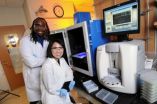(Press-News.org) SALT LAKE CITY—Many patients who have genetic testing for Lynch syndrome, a hereditary predisposition to colon cancer, receive the inconclusive result "variants of uncertain clinical significance." This can be a problem, as people with Lynch syndrome have a much higher probability to develop colon cancer, and often develop colon cancer at an earlier age than is common among the general population; consequently, they need to begin screening at a much younger age.
Now, between two-thirds and three-fourths of these genetic variants can be classified into categories that indicate the most appropriate screening and treatment guidelines, according to two complementary papers published in this month's Human Mutation Early View e-publication. The two papers, both co-authored by Sean Tavtigian, Ph.D., a Huntsman Cancer Institute (HCI) investigator and associate professor in the Department of Oncological Sciences at the University of Utah, provide a model that could help physicians as they assess their patient's risk to develop cancer.
According to the American Cancer Society, about 143,460 new cases of colon cancer will be diagnosed in the United States this year. The National Cancer Institute estimates that two to four percent of all colon cancer is attributable to Lynch syndrome.
Mutations in mismatch repair genes, which proofread DNA to correct genetic typos that occur during the replication process, are known to be the cause of the syndrome. "Some people in families with Lynch syndrome have already known mutations, and a small number of missense substitutions have also been classified as pathogenic," said Tavtigian. "But a fair number have other missense substitutions for which the clinical significance could not be determined, creating uncertainty concerning proper screening and treatment for patients and physicians alike."
The first of the two studies reported on standardizing several already available computer programs that grade the severity of missense substitutions (at the genomic level, these mutations affect only a single structural unit of DNA rather than an entire gene; at the protein level, they affect only a single amino acid rather than the entire protein). The second describes how clinical data concerning the tumors, family history, and other factors were combined with that initial information about severity. Taken together, the procedures described in the two papers allow previously unclassified genetic variations to be assessed for the level of risk they pose in colon cancer development.
"Using these tools, we can evaluate any particular missense substitution and come up with a percentage indicating the probability that it is pathogenic," said Tavtigian. "I'm very careful to avoid saying pathogenic or neutral as an either-or statement. With missense substitutions, I don't believe in a binary classification." A scale developed by his team in 2008 indicates the appropriate level of clinical action for a given percentage of risk, he adds.
Tavtigian is senior author on the first study. Amanda B. Spurdle, Ph.D., associate professor of molecular cancer epidemiology at the Queensland Institute of Medical Research, Brisbane, Australia, is senior author of the second paper, and Tavtigian is a co-principal investigator.
As a result of this research, HCI now has a Web site that physicians, researchers, and even the public can use to look up the probability that a missense substitution in any of the four colon cancer mismatch repair genes is pathogenic. In the future, HCI plans to develop a "suite of Web sites dedicated to unclassified variants in many clinically important cancer susceptibility genes," according to Tavtigian.
###
The articles lists nearly 40 co-authors from HCI, the U of U, and other research organizations based in North America, Australia, and Europe, including the Colon Cancer Family Registry, an international consortium with hundreds of members. Funding from the National Institutes of Health, P30 CA042014, and many worldwide cancer research foundations supported the study.
The mission of Huntsman Cancer Institute (HCI) at The University of Utah is to understand cancer from its beginnings, to use that knowledge in the creation and improvement of cancer treatments, to relieve the suffering of cancer patients, and to provide education about cancer risk, prevention, and care. HCI is a National Cancer Institute-designated cancer center, which means that it meets the highest national standards for cancer care and research and receives support for its scientific endeavors. HCI is also a member of the National Comprehensive Cancer Network (NCCN), a not-for-profit alliance of the world's leading cancer centers that is dedicated to improving the quality and effectiveness of care provided to patients with cancer. For more information about HCI, please visit www.huntsmancancer.org.
END
Vision may be less important to "seeing" than is the brain's ability to process points of light into complex images, according to a new study of the fruit fly visual system currently published in the online journal Nature Communications.
University of Virginia researchers have found that the very simple eyes of fruit fly larvae, with only 24 total photoreceptors (the human eye contains more than 125 million), provide just enough light or visual input to allow the animal's relatively large brain to assemble that input into images.
"It blows open how we think about vision," ...
Physician-researchers at Indiana University School of Medicine have reported the first effective therapy for a class of previously untreatable and potentially life-threatening tumors often found in children.
Announcing their findings in the online first edition of Lancet Oncology, the researchers said the drug imatinib mesylate, marketed as Gleevec as a treatment for chronic myeloid leukemia, provided relief to a significant number of patients with plexiform neurofibromas, tumors caused by neurofibromatosis type 1, or NF1.
"Although this was a small study, the results ...
The most-distant, super-luminous supernovae found to date have been observed by an international team, including Raymond Carlberg of the University of Toronto's Department of Astronomy & Astrophysics. The stellar explosions would have occurred at a time when the universe was much younger and probably soon after the Big Bang.
"The objects are both unusually bright and unusually slow to fade. These are properties that are consistent with what is known as pair-instability supernova, a rare mechanism for explosion which is expected to happen for high-mass stars with almost ...
Tendon injuries affect athletic horses at all levels. Researchers from the University of Connecticut are studying the use of stem cells in treating equine tendon injuries. Their findings were published Oct. 16 in the Journal of Animal Science Papers in Press.
Tendon injuries in horses tend to worsen over time as damage to the tendon creates lesions. Currently, horse owners treat tendon injuries by resting the horse and then carefully exercising the horse to control the growth of scar tissue in the tendon. Unfortunately, this treatment does not always work.
"These injuries ...
New Orleans, LA – Research led by Chu Chen, PhD, Associate Professor of Neuroscience at LSU Health Sciences Center New Orleans, has identified an enzyme called Monoacylglycerol lipase (MAGL) as a new therapeutic target to treat or prevent Alzheimer's disease. The study was published online November 1, 2012 in the Online Now section of the journal Cell Reports.
The research team found that inactivation of MAGL, best known for its role in degrading a cannabinoid produced in the brain, reduced the production and accumulation of beta amyloid plaques, a pathological hallmark ...
Many educators have long believed that when words differ on only one sound, early readers can learn the rules of phonics by focusing on what is different between the words. This is thought to be a critical gateway to reading words and sentences.
But scientists at the University of Iowa are turning that thinking on its head. A recent study published in "Developmental Psychology" shows certain kinds of variation in words may help early readers learn better. When children see the same phonics regularities, embedded in words with more variation, they may learn these crucial ...
Using advanced microscopes equipped with tissue-penetrating laser light, cancer imaging experts at Johns Hopkins have developed a promising, new way to accurately analyze the distinctive patterns of ultra-thin collagen fibers in breast tumor tissue samples and to help tell if the cancer has spread.
The Johns Hopkins researchers say their crisscrossing optical images, made by shining a laser back and forth across a biopsied tissue sample a few millionths of a meter thick, can potentially be used with other tests to more accurately determine the need for lymph node biopsy ...
Fairfax, Va. -- A malarial drug is showing promise in stopping breast cancer before it starts, Mason researchers are discovering during a clinical trial.
"The bold long-term goal is a short-term oral treatment that prevents breast cancer by killing the precursor cells that initiate breast cancer," says Lance Liotta, co-director of Mason's Center for Applied Proteomics and Molecular Medicine (CAPMM). "And it's looking hopeful."
The PINC trial (Preventing Invasive Neoplasia with Chloroquine) targets ductal carcinoma in situ, or DCIS, the most common type of pre-invasive ...
Predicting how atherosclerosis, osteoporosis or cancer will progress or respond to drugs in individual patients is difficult. In a new study, researchers took another step toward that goal by developing a technique able to predict from a blood sample the amount of cathepsins—protein-degrading enzymes known to accelerate these diseases—a specific person would produce.
This patient-specific information may be helpful in developing personalized approaches to treat these tissue-destructive diseases.
"We measured significant variability in the amount of cathepsins produced ...
STANFORD, Calif. — Stanford University School of Medicine scientists have used bioengineered mice with livers composed largely of human cells to characterize a drug about to enter early-stage clinical development for combating hepatitis C.
Tests using the new mouse model accurately predicted significant aspects of the drug's behavior in humans — including its interaction with another drug and the profile of its major breakdown products in the body (called metabolites) — far more accurately than would have been achieved using current methods.
The study will be published ...


